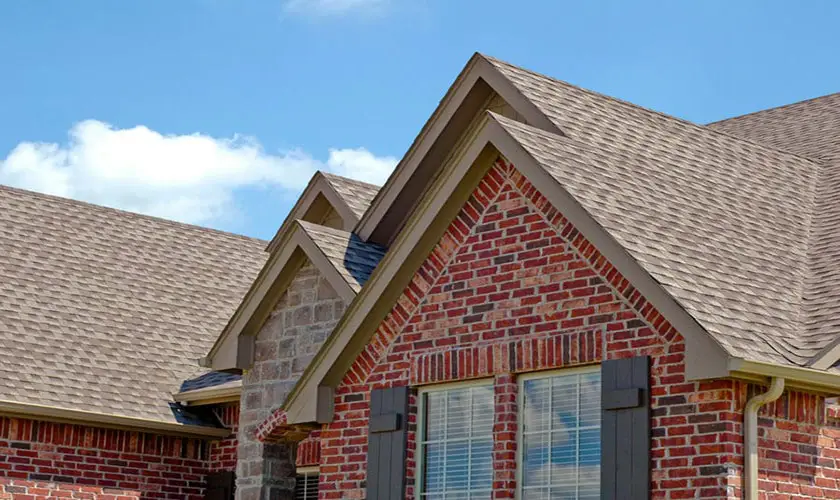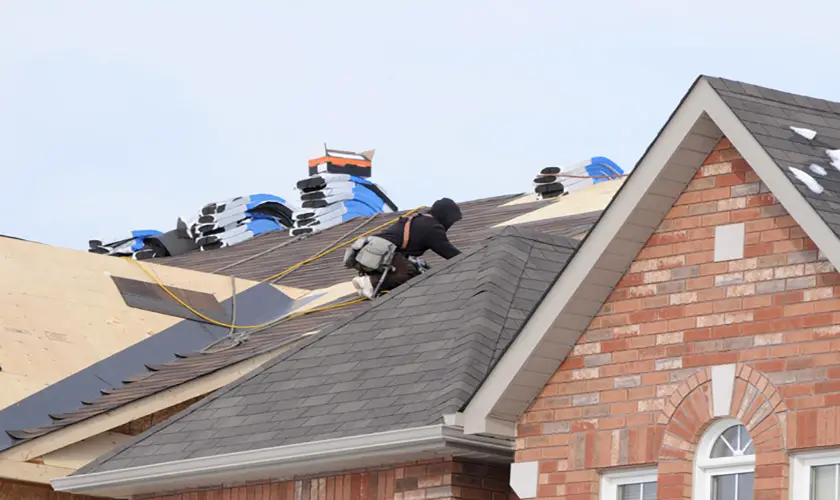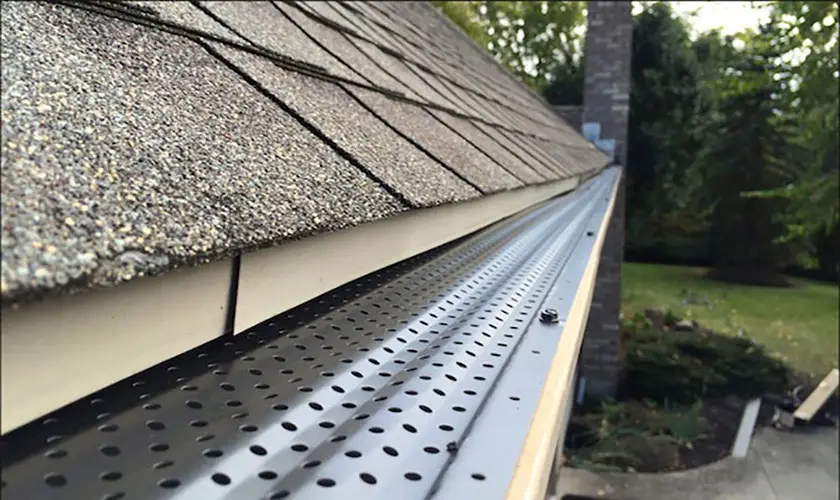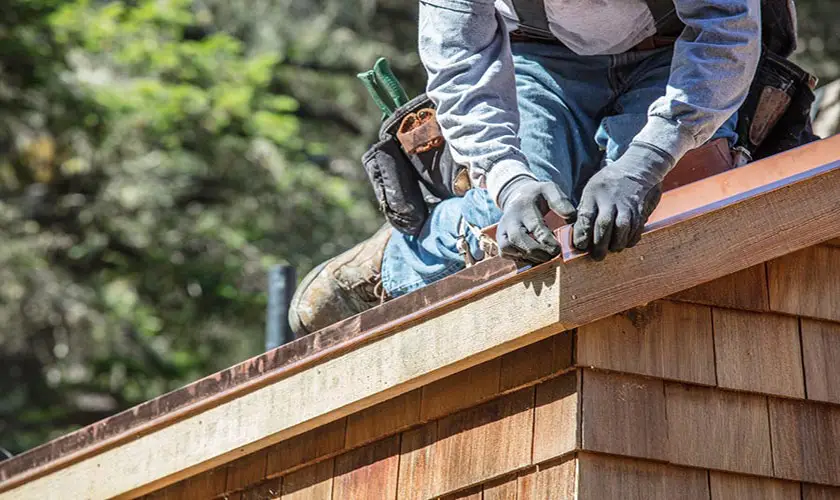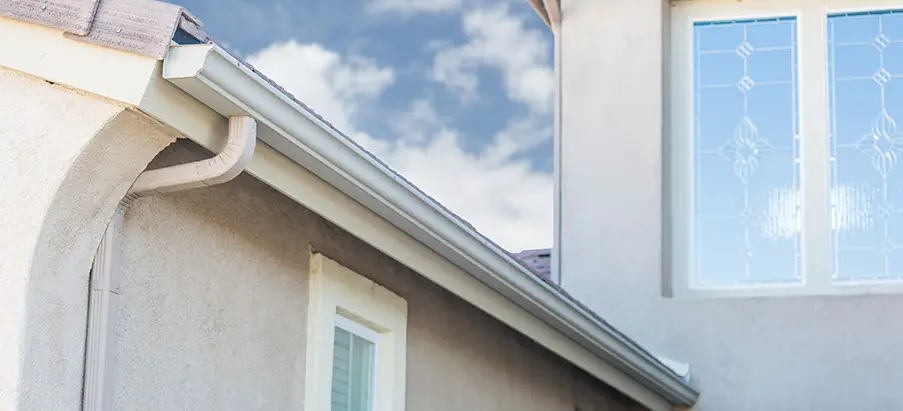
There are common misconceptions about how far a gutter should extend off the roof. Homebuilders have debated the answer, with some stating that it depends on the demands your gutter will face based on your region. However, across the board, industry standards exist to ensure your gutters are installed correctly regardless of where your home is located.
In most areas, gutters will be installed against the fascia, with about 3″ to 4″ of the gutter width extending beyond the edge of the shingles. Depending on the fascia pitch, gutters may need a bracket installed behind the rear gutter wall to sit level.
The back edge of the gutter should rest under the lip of the drip edge flashing to prevent water intrusion behind the gutter. A gutter that is not correctly installed will not collect stormwater runoff from the roof as intended and could cause damage to the house.
This is how far a gutter should extend past your roof edge and other tips to get the longest use out of your gutters.
Recommended Reading: Are Gutter Guards Worth It or a Waste of Money? We Ask the Pros
How Do I Know My Gutter Is Properly Installed?
You know a gutter is installed correctly if it can drain. Gutters should have a slight tilt to ensure they drain towards the downspouts. That said, be aware of gutters that have a “rainbow” shape or sag in places. Too much bowing is bad for the gutter’s structural integrity and doesn’t appear best.
A brief spot check of your current gutters can give you an idea of whether or not they need to be reinstalled soon. Look for signs of gutters that are too loosely attached or are not aligned with the correct sloping. Gutters without proper sloping contribute to water damage.
On the contrary, the surest guarantees to preserve your roof from water damage are well-installed, well-maintained gutters.
Supplies For Installing New Gutters
Before you install new gutters, acquire all the needed materials. A simple checklist of materials will let you know you have purchased enough material and material of the correct durability grade.
Caution: You will need an extension ladder to finish this job. Refer to the OSHA labor guide for protecting roofing workers for safety requirements and procedures when using extension ladders and general roofing safety.
To install new gutters, you will need:
- Gutter
- Gutter flashing
- Roofing nails and screws
- Downspouts and elbows
- Gutter sealant, ice, and water barrier
- Replacement fascia boards (optional)
- Furring strip (optional)
Manufacturer’s manuals can provide insights into the durability of these general products. Acquiring the highest-potential durability material, even in lower-risk environments, is recommended to promote roofing longevity.
Should Gutters Be Longer Than The Roof?
Gutters extend past the roof to provide the correct watershed. Most regions require gutters with downspouts for the proper watershed. By extending past the roof by roughly an inch and a half or, as This Old House experts stated, “the length of a finger,” the gutter is directing the watershed away from the surface of the roof. This ensures that water does not get trapped in the shingles and begins to break down the roof’s material integrity.
Gutters come in various materials ranging from aluminum gutters to bronze gutters. Some common trends also include PVC-UE and PVC-U gutters.
How Far Should Gutters Stick Out?
Gutters should have a slight overhang and be slightly pitched to ensure the correct water runoff. In addition, they should stick out to provide a drain that does not splash back onto the roof and siding.
Gutters are installed along with an L-shaped metal drip edge acting as a roof water drain. It is recommended to have the drip edge installed with a 1×2 furring strip to act as a small buffer between the drip edge and the fascia boards.
It is also recommended to check your state building codes for information on local climate conditions and how installation procedures may vary, see, for example, Florida Building Code-Residential regarding drip edge.
Building codes include design recommendations. The recommended roof design in Florida was a hip roof for its sloping. Consulting local building codes can give you an estimate of best practices for your region’s climate and best practices for the greatest roof longevity.
Along with building codes, your material provider will often give insights on how best to install their product for maximum use.
Gibraltar brand states that its gutters should be installed along the eaves at a corner and working around, overlapping each subsequent piece 2-3 inches.
Once you install the eave drip edge, you then apply underlayment, and once you apply underlayment, you then apply the drip edge to the rakes. This brand suggests nailing the gutter to the roof edge every 16-24″, depending on local wind conditions.
How Far Should Shingles Extend Past The Drip Edge?
Roofing professional service GAF suggested that shingle edges extend 3/8″- 3/4″ (9 mm-19 mm) from the roof’s edge. They should not extend more than this because too long shingles will corrode and break off. Shingles should extend slightly over the inside gutter edge to allow water runoff into the gutter.
Should Gutters Be Flush With Fascia Boards?
Gutters are installed on the face of the fascia boards. Laying down a protective piece of the furrier strip is recommended rather than leaving them flush. This is because fascia will be exposed to dark and dampness. It will require proper insulation and maintenance to preserve.
For this reason, the fascia board needs to be painted infrequently. Instead, homebuilders’ leading resources have recommended painting fascia with a cover coat and oil-based paint, including “This Old House.”
How To Fix The Gap Between The Roof And The Gutters
Inclement weather conditions can take their toll on your roof and gutters creating gaps between them. This gap can expose under materials and the wall to water and wind damage. You’ll need to replace bowing and gaps to preserve the roof to keep the gutter from falling off.
Repairs to this gap are also important for maintaining the roof’s integrity, as gaps between pieces can lead to a pile-up of debris in the roof’s structure.
Note on Gutter Cleaning
Once gutters are installed and all repairs are made, frequent gutter cleaning will increase the gutters’ longevity. Tools such as GutterSweep have been specifically designed to keep gutters cleaned. In addition to these products, rain guards have been designed to fit inside the gutter’s edges to keep large debris out and allow water to drain continuously.
Caution: If cleaning the gutter manually, acquire Personal Protective Equipment such as gloves and masks to avoid harmful contact with gutter debris. Execute standard ladder safety when cleaning gutters or when maintenance gaps and other damages to the gutter installation.




